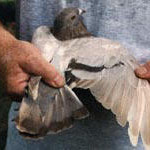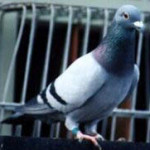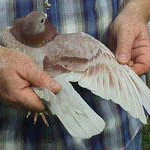by Frank Mosca, Copyright 2000
published with permission from author
Domestic pigeons have three different feather pigments: brown, black and red. Despite our common pigeon terminology usage, there is no blue pigment in pigeons. The reason we’ve always used the term is because when the black pigment is clumped together in the cells of the feathers, it refracts the light in such a way that we see a bluish tinge. Note the wingshield of the blue bar. This is why W.F. Hollander decided to designate the wild-type pigment as blue/black. This terminology helps us to remember that when we speak of “blue” pigeons of any pattern, we’re actually talking about birds with black pigment.
| Brown | Blue | Ash Red |
|---|---|---|
 |
 |
 |
All pigeons that you’ve ever seen, whether show or fancy pigeons like the Lahore, King, or Brunner Cropper, or whether flying birds like the Birmingham Roller, Racing Homer or Tippler, have been colored by one of these three pigments. They are the base upon which the other color mutations work. All three of these pigments are various chemical forms of melanin, the coloring pigment even humans have. In us, too, the melanin, though black, can produce a bluish hue. That’s why some humans have blue eyes. When the pigeon’s pigment is spread out rather than clumped, we see black. That’s why the bars in the wing and the tail appear as they do.
The original ancestor to all domestic pigeons, the rock dove (Columba livia) of Eurasia and parts of Africa, is a blue barred patterned bird similar in almost all color aspects to the blue bar race bird pictured here. This color is the wild type color and it is the color we use as our measuring standard. Any change (mutation) from this color is compared to it. Many breeding tests have shown that the brown mutation is recessive to the wild type color. This means if a pure (homozygous) blue bar cock is mated to a pure (hemizygous) brown bar hen, that all the youngster produced will be blue bars, with the males carrying brown but not showing it.
Ash-red is the second mutation that has taken place at the spot on the chromosome where pigment color is determined. However, ash-red is different from brown since ash-red was found to be dominant to wild type. Since it is dominant, you might well expect that if you mate a homozygous blue bar cock to a hemizygous ash-red bar hen that you would get all ash-red young. Unfortunately, while seemingly logical, this doesn’t happen. What you get are ALL ash-red sons carrying blue (wild type) and all blue bar hens. The reason for this is that there is sex-linkage involved in the spot where the pigment mutations have happened. Don’t worry about sex-linkage for now, but let me just tell you what would happen with some various matings of birds which are either homozygous (cocks) or hemizygous (hens) for their particular pigment: In the following examples the x means: mated to. Remember also that blue implies wild type.
- Brown cock x Blue hen – all blue sons carrying brown; all brown daughters
- Blue cock x Brown hen – all blue sons carrying brown; all blue daughters
- Blue cock x Blue hen – all blue sons; all blue daughters
- Blue cock x Ash-red hen – all ash-red sons carrying blue; all blue daughters
- Ash-red cock x Blue hen – all ash-red sons carrying blue; all ash-red hens
- Brown cock x Ash-red hen – all ash-red sons carrying brown; all brown hens
- Ash-red cock x Brown hen – all ash-red sons carrying brown; all ash-red hens
These are not all possible combinations, but should give you an idea of what can be expected.
Now look at the photos shown and note the differences between the brown mutation and the ash-red one. Look first at the tail bars of the birds. With brown, you can see a tail bar; with ash-red you can’t – the tail is ashy (this ashy color of the tail and wings is the reason Hollander gave the mutation the name: ash-red.). Note that the wing bars of the brown are chocolate colored, while those of the ash-red’s are a brick red. Note also that the pattern, the bars of the birds are still visible and similar in size and placement to those of the blue (wild type.)
There is only one more thing now. Terminology. Remember I said brown is recessive to wild type, and that ash-red is dominant to wild type? That’s because the blue bar (wild type) is our standard, our “sea level” measurement if you will. Every mutation is referred back to this standard. Because of this, I really shouldn’t say blue is recessive to ash-red; rather I should say ash-red is dominant to blue. In like manner, I should always say brown is recessive to wild type and not that blue is dominant to brown. We sometimes fall into that habit when talking casually with other breeders but it’s not right and should be avoided. One real reason for this is because it’ll make it much easier for you to figure out probable young from a mating, especially when more than one factor is involved. For example: you may have a mating between a heterozygous Qualmond, heterozygous Spread, heterozygous dilute cock and a hemizygous dilute, heterozygous check, ash-red hen. Trust me, if you can relate everything back to the wild type, this is a cinch to figure out.
Just remember: Pigeons have three pigments; brown, blue/black, red. Brown is recessive to wild type; ash-red is dominant to wild type. All pigeons are one of these pigment types, though other modifiers and mutations may make it hard to see what the base pigment is.
You must log in to post a comment.